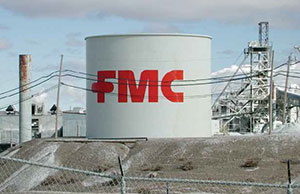
Mesh Meets Mining
Video surveillance bolsters safety, security at Wyoming operation
- By Pramod Akkarachittor
- Apr 01, 2013
 FMC Corp. is a diversified, chemical company
with leading positions in agricultural,
industrial and consumer markets.
Since the company’s inception in 1883,
FMC has been providing solutions to
companies worldwide and to their customers. Today,
FMC uses an array of advanced technologies in research
and development to improve the delivery of
medications, enhance foods and beverages, power batteries,
protect crop yields and advance the manufacture
of glass, plastics, paper, textiles and other products.
FMC Corp. is a diversified, chemical company
with leading positions in agricultural,
industrial and consumer markets.
Since the company’s inception in 1883,
FMC has been providing solutions to
companies worldwide and to their customers. Today,
FMC uses an array of advanced technologies in research
and development to improve the delivery of
medications, enhance foods and beverages, power batteries,
protect crop yields and advance the manufacture
of glass, plastics, paper, textiles and other products.
FMC owns and operates the largest trona mining
and soda ash processing plant in Wyoming’s Green
River Basin and is recognized as the world’s No. 1
producer of natural soda ash, offering a secure, reliable,
diverse range of high-quality, product choices.
Soda ash has been used in manufacturing for more
than 5,000 years. Ancient Egyptians recovered the
product from dry lake-bed deposits or manufactured
it by burning seaweed and other marine plants. The
product was first used to make glass ornaments, bake
bread and for medicinal purposes.
Located on the high plains of southwestern Wyoming,
the Green River Basin holds the world’s largest
reserves of trona ore that is mined at depths between
800 and 1,600 feet, and then brought to the surface to
be processed into soda ash. Deep in the underground
mines, employees work in noisy, dimly-lit conditions
amid clouds of trona dust. On the surface, mine workers
operate heavy machinery to process the extracted
trona into powdery soda ash. Today, soda ash is a
significant global economic commodity because of its
applications in manufacturing glass, chemicals, paper,
detergents, textiles, food and more.
Mine Safety: Always Prepared
for the Unlikely
Historically, the very nature of the mining industry
places miners and operators in extremely harsh and
dangerous environmental conditions that are deemed
hazardous and have led to injury, illness and even
death. Today’s miners continue to battle extreme
workplace conditions in remote areas, but due to
technological advances, the mining industry is turning
the tables on the “hazardous” stereotype that has
plagued the industry for years.
FMC places the highest priority on protecting
the environment and the dedicated people who work
their facilities. FMC has a responsibility to protect
the health and safety of all their employees, business
partners, neighbors and customers. Providing a safe
and healthy work environment is paramount to protecting
all involved and maintaining successful, business
operations. Throughout FMC, investing time,
money and resources into safety training to prepare
for worst-case scenarios and working closely with local
emergency responders is a top company priority.
The mine rescue teams at FMC’s Granger, Wyo.,
site consistently rank in the top echelon of national,
emergency-preparedness competitions. While trainers
throughout the year prepare for mine emergency
response, the team hopes they never have to use it.
One of the key tools FMC relies on for security and
emergency response situations is a state-of-the-art,
wireless-mesh video network.
Harsh Environment,
Lack of Existing Fiber
Designing a reliable, high-performance wireless network
for FMC’s soda ash mine in Wyoming was particularly
challenging and required careful selection
of network equipment that would accommodate the
wide range of environmental forces. The customer
required the outdoor network to be capable of withstanding
temperatures that drop to minus 40 degrees
during winter; high temperatures greater than 100 degrees
F.; heavy snowfall; extreme, high winds and a
dusty, soda ash, mine environment.
To help determine the most cost-effective, workplace
safety and security system, the operations team
at FMC turned to SimplexGrinnell, a security systems
integrator that designs, engineers, manages and
deploys security, fire, life safety and property protection
systems. After thorough investigation and site
surveys, SimplexGrinnell concluded that FMC’s soda
ash mine required an extremely robust and reliable,
wireless video surveillance solution to monitor the
mine sites and provide a higher level of workplace
safety and security.
Given the limited existing cable and fiber infrastructure,
it was clear that FMC needed a wireless
mesh network that could support the bandwidth required
for capturing high-quality video, while providing
instantaneous control of high-performance PTZ
cameras. After looking over several wireless vendors,
SimplexGrinnell selected Firetide to supply the wireless
infrastructure, mesh, video network to monitor
the 40-square-mile plant and including its operations.
“In the past, FMC could only have cameras in the
limited areas where cabled infrastructure was available,”
said Robert Oldham, integrated security solutions
expert for SimplexGrinnell. “Firetide’s wireless
infrastructure, mesh networks allow FMC to easily
and cost-effectively expand their video surveillance
network to cover more mine shaft sites and to provide
an increased level of security that would not
have been otherwise possible. The ability to deploy
high-quality video and PTZ camera control to remote
locations eliminated the need for remote servers or
video recording systems and allowed us to place the
expensive servers and storage at a centralized, secure
location and then deploy cameras anywhere needed,
dramatically increasing the reliability and serviceability
of the system.”
Wireless Mesh
Infrastructure Solution
Industrial mining sites have a variety
of security and communications challenges
that can be quickly and costeffectively
solved with wireless mesh
networks. Wireless mesh enables rapid
deployment of wireless networking infrastructure
to provide protection and
connectivity 24/7 for employee mobility,
real-time video surveillance, LAN
extension and VoIP/radio over IP communications.
With a wireless mesh network,
mining operations can realize
the benefits of IP-based access control,
theft prevention, asset protection, infiltration
or vandalism prevention, employee
safety, evidentiary records procurement
and secure communications.
At FMC, the wireless mesh network
connects IP video cameras located at
multiple plantwide locations, enabling
security staff to centrally monitor activity
from a command center 24/7. The
wireless network enables FMC’s security
forces to view large areas surrounding
the mine shaft sites in real time,
providing the ability to make informed
decisions depending on the urgency
and type of response that is needed
for each incident. With the ability to
view live video feeds, the network improves
overall safety and enables faster
dispatch of security and safety officers
where and when they are needed.
The ability to deploy high-quality
video and PTZ camera control to remote
locations eliminated the need for
remote servers or video recording systems,
and allowed FMC to place the expensive
servers and storage at a centralized
secure location and then deploy
cameras anywhere they were needed,
increasing reliability and serviceability.
“This wireless network opens up the
door for us to deploy excellent video surveillance
at virtually any location for a
fraction of the cost of deploying cable or
fiber,” said FMC’s Cristian Diaz. “Furthermore,
the quality of the wireless network
enables us to provide a backbone
that enables camera operators to have
instantaneous control of the video cameras.
It is always a huge relief for IT when
we can provide a fast, reliable, standalone
network for our video cameras,
eliminating the need for us to consume
business-use, network bandwidth.”
The video security system at FMC’s
Wyoming soda ash mine currently includes
14 Firetide HotPort 7020 mesh
nodes, Firetide HotView Pro network
management software and 25 Panasonic
IP PTZ cameras. The wireless network
and video cameras are not only
used in emergency response situations,
but they also act as deterrents for falseinjury
claims and theft of construction
materials. Video feeds are securely
stored for 45 days and can be used as effective
evidence in court, reducing time
and expenses for prosecuting cases.
FMC and SimplexGrinnell began
deploying Firetide’s wireless infrastructure
mesh in 2010. As the value of the
wireless network became increasingly
noticeable, funds were allocated yearly
for new expansion phases. The network
continues to grow and is currently being
expanded to provide additional coverage
to the mine and
plant facilities.
This article originally appeared in the April 2013 issue of Security Today.